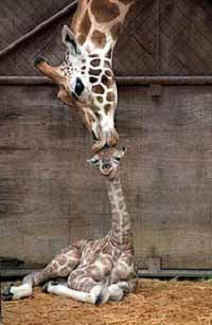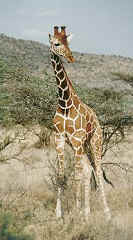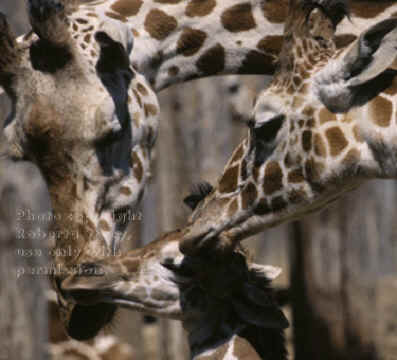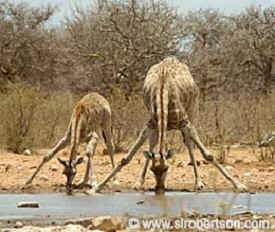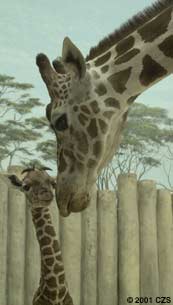
CLASSIFICATION
Kingdom: Animalia
Phylum:
Chordata
Class: Mammalia
Order: Artiodactyla
Family:
Giraffidae
Genus
species: Giraffa
GENERAL
INFO
The Reticulated Giraffe is a vertebrate deuterstome and
the tallest animal in the world!. Males reach a whole whopping 19 feet and
weigh about 2400-4250 lbs. Females can reach up to 17 feet tall and weigh
anywhere between 1540-2600 lbs. A lot of the giraffe's weight is in the
neck and head region which can weigh almost 500 lbs! It
has eucoelom and closed circulation. The giraffe also has an endoskeleton
and is endothermic. A female giraffe (cow)
can have as many as 12 calves in her life span of 20-25 years. The female
becomes mature anywhere from 4-5 years of her life and the male giraffe
becomes mature at about 3.5 years into his life but usually don't breed
until the age of 8 or so. The Reticulated Giraffe is also recognized
by it's wonderful spots.
HABITAT
The Reticulated
Giraffe is only native to Africa. They used to be in the dry savanna zones
south of the Sahara Desert, but today they have been restricted to most of
West Africa and southern Kalahari range. But still very common to see.
They live in dry, hot areas like the desert and savanna regions with lots
of vegetation. They do not live in South Dakota, but you can see them in
zoo's in SD or in other states. But you will only see them in their true
habitats in Africa.
DIET
The Reticulated Giraffe is
a herbivore, which means it only eats plants (greens). It mainly
feeds on the Acacia and Combretum trees, but will eat as many
as 100 different kinds of plants depending on what is available at the
time. Although mostly leaves and shoots are eaten, giraffe's also
eat flowers, vines, and herbs. In one case the giraffe is a
carnivore, it is been seen that is eats a weaver's bird nest with the baby
birds inside and will chew on the bones, perhaps for extra minerals or
so. It is said that on average a giraffe will spend 16-20 hours a
day feeding and eat up to a 140 lbs of food. And while eating foods
off trees, up to 6-foot band of foliage that is above the reach of other
animals except an elephant, you may wonder how the giraffe can tolerate
eating thorns in the trees. Well the thorns are not a problem for
the giraffe because of their long, prehensile, muscular tongue (which can
be extended up to 18 inches), thick, gluey saliva, and special upper
palate enable the giraffe to process thorny foods. But with all this
food, the giraffe only receives only a little amount of water. The
Reticulated Giraffe only drinks every 2 to 3 days and can go weeks without
it. But the giraffe does get a large amount of its water from the
dew on the leaves and the water in the leaves. So when it finally
encounters a drinking hole it can drink up to 12 gallons at one
time.
REPRODUCTION
The Reticulated Giraffe breeds
throughout the year, but most often after the rainy season. Then
after a gestation period of about 14 to 14 months, a 6-foot baby giraffe
(or otherwise known as a calf), if born. And when the calf is born
it drops about 6 feet from the mother and stands about 20 minutes after
birth on wobbly legs. Then within an hour the baby giraffe will
begin to nurse from the mother. The mother will guard her young for
the first 2 weeks, but if there are a lot of calves in one herd, one
female may take care of all the young till they are older. The
giraffes are separate sexes and have internal fertilization. They
give birth to live babies. Giraffes live in herds and can share the
task of taking care of their young. And they do not have one
lifetime mate.
BODY
SYSTEMS
The giraffe's circulatory system is specially
adapted to the long neck. It has elastic blood vessels in their neck and
head to handle changes in blood pressure due to their head swings. Since the
giraffe is a land mammal, it breathes with lungs. Their respiratory system
if pretty much the same from any other land mammal.
HUMAN
IMPACT
Humans do have an impact on the Reticulated
Giraffe. The humans hunt them in some areas of Africa to show off
what they can hunt and track and to have statues in their houses.
They are not endangered or threatened. We can help with their
population like any other animal and keep them in safe areas where they
cannot be hunted, or put them in National Parks, zoos, or wildlife
protective areas.
WEBLINKS
http://www.thebigzoo.com/Animals/Reticulated_Giraffe.asp
SOURCES
picture: http://www.brookfieldzoo.org/pagegen/images/2000002/girbaby3.jpg
http://www.oaklandzoo.org/atoz/azgiraf.html
http://members.tripod.com/~Jeff_Simon/index-6.html
http://www.honoluluzoo.org/giraffe.htm
Christina | 
